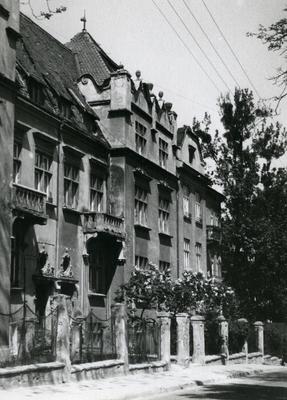Vul. Barvinskykh, 6-8 – residential buildings
The three-storied residential buildings number 6 and 8 were constructed together in 1911-1912 under a project designed by Jan Bagieński of the architectural bureau of Wojciech Dembiński and Zbigniew Hedinger. The buildings were constructed in the style of Historicism with a combination of late Renaissance, Neogothic, and Neobaroque elements, unusual for Lviv. Today they are used as residential ones.
Architecture
These two three-storied houses can be called city villas. Blocked houses with one apartment on each floor are shifted from the sidewalk into the depth of the plot, thus a place for a little garden is formed in front of the façade. Together, the buildings form a symmetrical composition (although they were to differ in details according to the original design).
Each house has a façade with four window axes. The narrower parts of the façades with the main entrances are shifted more deeply into the plot and have two floors. The wider two-window and three-storied parts are topped with attics. The entrances are located on the lateral axes. The door openings are rectangular, with wooden woodwork; above, there are round lights surrounded by Neobaroque stucco décor. Windows are rectangular; divided by vertical and horizontal imposts into four or six parts. The imposts have fascias typical for the late Gothic and Northern Renaissance. The second floor windows have pediments with thin molded friezes and volutes with obelisks above; the attics are decorated similarly, but on a larger scale. On the extreme axes of the first floor, there are balconies with massive molded fencing: between the columns, circles are arranged with S-shaped curves inside, a feature characteristic of the Flamboyant Gothic. There are similar balconies on the second floor; however, they have a lighter structure and no tracery. The authentic fence of masonry brick columns and a metal mesh has been preserved.
The houses have undergone no significant changes on the outside. One attic level was added (within the old roof); over the past few years, the house number 8 was re-plastered and painted with unauthentic shades of olive green. Some original wooden windows were replaced by plastic ones. The wooden entrance door is not authentic; however, it is made in the shape of the old one. A small plastic roof supported by metal consoles is arranged over one of the balconies.
One of the basement windows of the building number 6 is turned into a door leading to a doctor's office.
Personalities
Jan Bagieński — an architect, who worked in the architectural
bureau of Wojciech Dembiński before the First World War; the author of the
project of the house.
Tomasz Bieniawski — a co-owner of real estate (1911-1914), who
commissioned the construction of the house number 6; a postal super-counsellor,
who lived on Wincentego Pola (now Dorosha) street in 1913, then a resident of
the building kept by the Foundation for pensioners and employees of the
Regional Bank on Terezy street 2c (now Mytropolyta
Andreya street 8); in 1935, a retired president of the post and
telegraph, a resident of the building on Wagilewicza street 7.
Elżbieta Wanda Bieniawska, née Kurmanowicz — a co-owner of the
real estate, who commissioned the construction of the house number 6.
Stanisław Biesiadecki — a retiree, who lived in the house number 8.
Dr Julian Blatt — an industrialist, the owner
of the house in 1927, who then lived on Gosiewskiego (now Tershakovtsiv)
street 4.
Józef Czaczka — a co-owner, who commissioned the construction of
the house number 8; in 1897, a post office official and a resident of Gosiewskiego (now Tershakovtsiv) street 1; in 1911, a resident
of Kopcowa (now Kryvonosa) street 4; in 1913, a retired post office director.
Anna Czaczka, née Noworolska — the wife of Józef
Czaczka and a co-owner of the house number 8.
Wojciech Dembiński — a co-owner (together with Zbigniew Hedinger) of an
architectural and construction bureau.
Celestyn Gałasiewicz — a resident of the house number 6 in 1913.
Zbigniew Hedinger — a co-owner (together with Wojciech Dembiński) of an
architectural and construction bureau.
Władysław Janikowski — an official of the Regional Department, the owner
and resident of the house number 6 in 1897.
Julia Janikowska — the owner of the house number 4 in at least
1889-1897; in 1897, a retiree.
Stanisław Janikowski — an official (collector) of the Magistrate, a
resident of the house 4 in 1909.
Tomasz Janikowski — the owner of the house number 4 (conscription
number 38 4/4) in 1871.
Józef and Helena Januszkewicz — co-owners of the
house number 8 in 1935.
Bronisława & Kazimierz Krzyżanowski — owners of the house
number 6 (conscription number 38 4/4) in 1889.
Tadeusz Osada — a probationer at a savings bank, a resident of the
house number 8 in 1913.
Maria Peszl — a co-owner of the house number 6 in 1935.
Leszek Zajączkowski — a co-owner of the house number 6 in 1916.
Sources
1. State Archive of Lviv Oblast (DALO) 2/2/5083
2. DALO 2/2/5085
3. Księga adresowa królewskiego stołecznego miasta Lwowa (Lemberg, 1913).
4. Księga adresowa Małopołski (Lwów. Stanisławów. Tarnopól, 1935–1936).
5. Skorowidz krolewskiego stolecznego miasta Lwowa (Lemberg, 1872).
6. Skorowidz krolewskiego stolecznego miasta Lwowa (Lemberg, 1889).
7. Skorowidz królewskiego stołecznego miasta Lwowa (Lemberg, 1910).
8. Skorowidz królewskiego stołecznego miasta Lwowa (Lemberg, 1916).
9. Spis abonentów sieci telefonicznych... (Lwów, 1937)
By Olha Zarechnyuk
Media Archive Materials
Related Pictures















